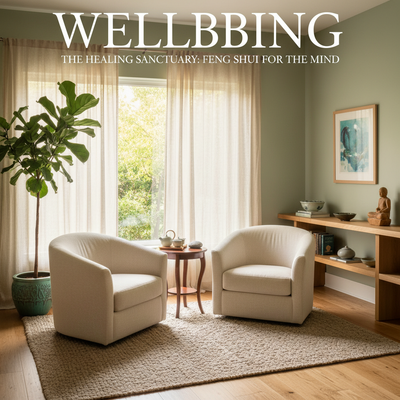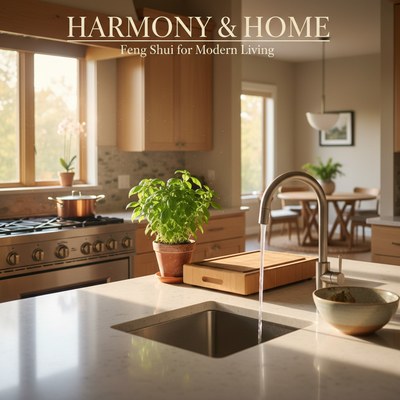The 3-Door Challenge

Having a bedroom with three doors can feel uncomfortable, and you're right to wonder about how it affects your home's energy. It's a common feature in modern homes, especially in main bedrooms with attached bathrooms and walk-in closets. The first question is often: is this bad feng shui? The simple answer is that it creates a big challenge, but it can definitely be fixed.
Multiple doors create multiple pathways for Qi (life energy) to enter and exit. This can lead to a space that feels messy, unsettled, and tiring, which is the opposite of what a bedroom should be. The energy moves too fast, stopping it from settling and helping you while you sleep. However, this is not a permanent energy problem. With the right knowledge and practical changes, you can manage this complex energy flow. This guide will walk you through understanding the problem, identifying your specific room's energy patterns, and using effective solutions to create a restful space.
Why Doors Disrupt Qi
To understand the solution, we must first understand the problem from a feng shui perspective. Your home, and every room within it, is filled with Qi, or life energy. In a bedroom, the ideal Qi is gentle, slow-moving, and helpful, like a slow-moving stream. This type of energy helps deep rest, healing, and connection. Doors are the main openings through which Qi enters and leaves a room. When you have one or two well-placed doors, this flow is manageable. With three or more doors, several specific problems happen.
-
Fast-Moving Qi / The "Highway Effect": Imagine trying to have a peaceful picnic in the middle of a three-way intersection. This is what happens to the energy in a feng shui bedroom with 3 doors. Qi rushes in from one door and shoots out another, creating a "highway" of fast-moving energy. This takes away the helpful, settled energy needed for good sleep. You may feel like you can never fully relax, even when you're tired.
-
Sha Chi / "Cutting Energy": When doors are directly lined up with each other, they create a sharp, aggressive path of energy known as Sha Chi, or "cutting energy." If your bed is located in this path, you are basically sleeping in a current of aggressive energy. This can show up as restlessness, arguments, and even health problems over time, as the energy is constantly "slicing" through your personal energy field.
-
Lack of Security and Stability: On a basic, unconscious level, multiple entry points create a sense of being unsafe. Your mind cannot fully switch off into deep sleep mode because it stays slightly aware of potential problems from three different directions. This lack of a secure, "yin" environment prevents you from feeling truly held and protected, which is a basic requirement for a peaceful bedroom.
Analyze Your Door Hierarchy
Not all doors are created equal. To solve the 3-door issue, you must first identify their roles and rank them in order of importance. This is an important step that allows you to apply solutions with precision instead of guessing. We call this the Door Hierarchy Analysis. It transforms a confusing layout into a clear, manageable problem.
Step 1: Identify the Main Entry Door
This is the primary door you use to enter the bedroom from the main part of the house, like a hallway or living area. This door brings in the most important and defining Qi for the room. Its location and relationship to the other doors and your bed are extremely important. This is your energy starting point.
Step 2: Identify the Secondary Functional Doors
These are the doors leading to other spaces connected to the bedroom. The most common examples are attached bathrooms, walk-in closets, or balconies. Each has a different energy function. A bathroom door can be a source of draining energy, as water and waste systems pull Qi away. A walk-in closet door can create a sense of mess or instability if left open. A balcony door, while bringing in fresh energy, can also create a strong in-and-out flow if not managed.
Step 3: Map the Energy Flow
Take a moment to draw a simple floor plan of your bedroom. Mark the location of all three doors and your bed. Now, draw lines connecting the doors. Do two doors face each other directly? Do the three doors form a triangle in the middle of the room? Is the bed positioned directly in the path between two doors? This simple visual map will instantly show where the "highway effect" and "cutting energy" are happening in your specific layout. For example, if the main door is directly opposite the bathroom door, this is a top priority to fix, as it can symbolically drain health and wealth energy as soon as it enters.
To help you organize your findings, use this simple framework:
| Door Location | Type | Potential Issue | Priority Level |
|---|---|---|---|
| e.g., To Hallway | Main Entry | Main Qi entry point; source of energy flow. | High |
| e.g., To Bathroom | Secondary | Drains Qi; introduces moisture energy. | High |
| e.g., To Closet | Secondary | Creates energy leaks; energetic clutter. | Medium |

| e.g., To Balcony | Secondary | Creates fast in/out flow; security. | Medium-High |
Nine Powerful Cures
Once you have analyzed your door hierarchy and mapped the energy flow, you can use targeted solutions. We have organized these cures into three levels, from simple, immediate changes to more involved structural changes. You can combine multiple cures for the best effect.
Tier 1: Subtle Cures
These are easy, low-cost solutions that can be used right away. They are best for secondary doors (like closets) or doors that are not in a direct, aggressive alignment.
-
Keep Doors Closed: This is the simplest and most powerful first step. By keeping the secondary doors to the bathroom and closet closed, you immediately stop the energy drain and cross-currents. Make it a non-negotiable habit, especially when you are sleeping.
-
Use Color to "Hide" a Door: For a less-used secondary door, paint it the exact same color as the surrounding walls. This includes the trim and the door handle if possible. This visual trick makes the door "disappear" energetically, reducing its importance and its effect on the room's Qi flow.
-
Hang a Feng Shui Crystal Ball: A multi-faceted crystal ball is a classic tool for spreading energy. If you have two doors creating a direct path of Sha Chi, hang a crystal ball from the ceiling roughly halfway between them. The facets will break up the fast-moving energy, scattering it gently around the room instead of letting it rush through.
Tier 2: Active Blockers
These cures are more intentional and involve using physical objects to interrupt problematic energy flows. They are ideal for addressing doors that create a direct path of cutting energy.
-
Strategic Furniture Placement: The most effective way to stop Sha Chi is to physically block it. Place a solid object between the problematic doors. A beautiful folding screen, a tall and leafy plant, or an open-backed bookshelf (which filters energy rather than stopping it completely) can all work wonders. The key is to interrupt the direct line of sight between the doors.
-
Use a Grounding Area Rug: An area rug, particularly a heavy or plush one, can do wonders to slow down and pool Qi. For a room where energy feels chaotic and scattered, place a circular rug in the center of the triangular flow between the three doors. A circle encourages the energy to move gently. A heavy, rectangular rug can also work to anchor the energy of the entire room.
-
Install Door Curtains: For a closet that has no door, or to soften the harshness of a secondary doorway, a beaded curtain or a heavy fabric curtain is an excellent solution. It doesn't completely block access but effectively slows and filters the Qi that passes through, turning a rush of energy into a gentle trickle.
Tier 3: Advanced Solutions
For the most challenging layouts where simpler cures aren't enough, these more structural solutions provide a powerful and permanent fix.
-
Hide a Door: If one of the three doors is rarely used (e.g., a secondary closet or an extra entry), you can make it truly invisible. This can be done by installing a "murphy door" or a hidden bookshelf door. A simpler method is to apply the same wall molding and paint over the door, effectively sealing it into the wall visually and energetically.
-
Re-hang the Door: Sometimes, simply changing the direction a door swings can redirect the flow of energy. If a door swings open to direct energy right at your bed, see if it can be re-hung to swing back against a wall instead. This can redirect the initial rush of Qi away from your sleeping area.
-
The "Invisible" Door Anchor: For a main door that cannot be blocked, you can symbolically anchor its energy. Place a heavy, grounding object just inside the room next to the door. A substantial sculpture, a large ceramic pot, or a heavy floor vase serves as an energetic anchor, preventing the Qi from immediately rushing away from the entrance.
A Real-World Example
Theory is important, but seeing it in action is powerful. We, at THE QI FLOW team, recently worked with a client facing this exact challenge, and their story shows how these principles create real change.
The Problem: Our client came to us complaining of chronic restless sleep, feeling constantly "on edge" in their own bedroom, and experiencing more frequent minor disagreements with their partner since moving in. Their main bedroom had a classic 3-door layout: a main door from the hall, a door to a large walk-in closet, and a door to an attached bathroom. The layout created a problematic "T-junction" of energy, with the path from the hall door to the bathroom door cutting directly across the foot of their bed.
Our Analysis: Applying the Door Hierarchy Analysis, we identified the main door as the primary energy source. The bathroom door was the most significant problem, acting as a major draining influence directly in line with the incoming Qi. The closet door, located on an adjacent wall, was creating a secondary cross-current that added to the chaotic feeling.
The Solution in Action: We used a layered, three-step solution.
1. First, we addressed the most critical issue: the bathroom door. We advised the client to keep the door closed at all times. More importantly, we had them place a slim, full-length mirror on the outside of the bathroom door. In feng shui, mirrors push energy away. This application prevented the bathroom from "sucking" the vital Qi out of the bedroom and deflected the energy rushing from the main door.
2. Next, for the closet door, we wanted to slow the energy without completely blocking easy access. We recommended a beautiful, heavy curtain in a dark, grounding color. This softened the doorway energetically and stopped the disruptive cross-current of Qi.
3. Finally, to balance the entire space, we had the client place a large, plush, circular wool rug in the area between the three doors. This created a central point for the energy to pool, slow down, and move gently throughout the space, helping the entire room.
The Result: Within two weeks, the client reported a dramatic improvement in sleep quality. They described the feeling as "finally being able to take a deep breath" in their own room. The sense of being "on edge" was gone, replaced by a clear sense of calm and stability. They also noted a return to harmony in their relationship, a direct reflection of the now-balanced energy in their shared space.
Essential Bedroom Adjustments
With the door energy managed, you can perfect the rest of your sanctuary. Solving the feng shui bedroom with 3 doors problem is a huge step, but it works best when supported by other basic feng shui principles.
The Command Position
This is the most important principle for bed placement in any bedroom. The command position means you can see the main entry door from your bed without being directly in line with it. This puts you in symbolic "command" of your life and your space, allowing your unconscious to relax because you can see anyone or anything that enters. In a 3-door room, it's even more important to avoid the direct line of fire from any door.
- Do: Place your bed against a solid wall, preferably diagonally opposite the main door. Make sure you have a solid headboard for support.
- Don't: Place your bed with its headboard under a window (lack of support).
- Don't: Place your bed directly in line with any door, where your feet point directly out the door (the "coffin position").
- Don't: Share a wall with a toilet or stove on the other side.
Colors, Materials, and Lighting
The final layer of creating a balanced bedroom is the sensory experience.
* Colors: Choose calming, yin colors. Earth tones, soft neutrals, and a range of skin tones (from pale beige to rich chocolate) are excellent choices. They are grounding and help rest. Avoid overly bright, stimulating "yang" colors like bright red or orange.
* Materials: Focus on natural, soft materials. Think cotton sheets, a wool blanket, a wood headboard, and linen curtains. These materials have a calming, natural energy, unlike synthetic materials like polyester.
* Lighting: Avoid harsh, overhead lighting, which is jarring to the nervous system. Instead, use layered lighting. Have soft bedside lamps, perhaps a gentle floor lamp, and install a dimmer switch for the main light. This allows you to control the mood and transition gently into a state of rest.
Take Control of Energy
A bedroom with three doors is not a feng shui curse; it is an architectural feature that presents an opportunity to become a conscious director of the energy in your personal space. By understanding the flow of Qi and the specific challenges of your layout, you can transform what feels chaotic into a space that is balanced and deeply supportive.
Remember the key action steps:
1. Analyze your unique layout using the Door Hierarchy method to identify your priorities.
2. Choose and layer the right cures—from simple adjustments to active blockers—for your specific energy map.
3. Support these changes with the basic principles of proper bed placement, calming decor, and soft lighting.
You now have the expert knowledge and practical tools to turn a challenging layout into a balanced, restful, and helpful sanctuary. The power to create a harmonious home that supports your well-being is, and always has been, in your hands.








0 comments